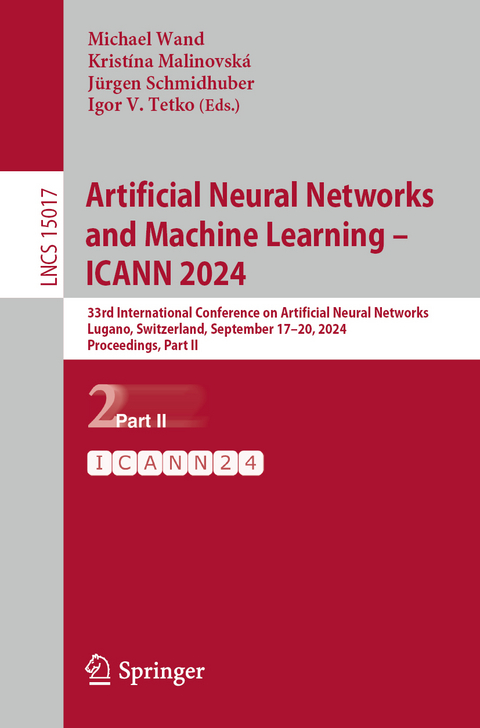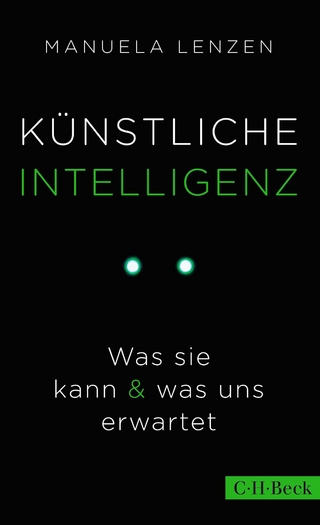
Artificial Neural Networks and Machine Learning – ICANN 2024
Springer International Publishing (Verlag)
978-3-031-72334-6 (ISBN)
The ten-volume set LNCS 15016-15025 constitutes the refereed proceedings of the 33rd International Conference on Artificial Neural Networks and Machine Learning, ICANN 2024, held in Lugano, Switzerland, during September 17-20, 2024.
The 294 full papers and 16 short papers included in these proceedings were carefully reviewed and selected from 764 submissions. The papers cover the following topics:
Part I - theory of neural networks and machine learning; novel methods in machine learning; novel neural architectures; neural architecture search; self-organization; neural processes; novel architectures for computer vision; and fairness in machine learning.
Part II - computer vision: classification; computer vision: object detection; computer vision: security and adversarial attacks; computer vision: image enhancement; and computer vision: 3D methods.
Part III - computer vision: anomaly detection; computer vision: segmentation; computer vision: pose estimation and tracking; computer vision: video processing; computer vision: generative methods; and topics in computer vision.
Part IV - brain-inspired computing; cognitive and computational neuroscience; explainable artificial intelligence; robotics; and reinforcement learning.
Part V - graph neural networks; and large language models.
Part VI - multimodality; federated learning; and time series processing.
Part VII - speech processing; natural language processing; and language modeling.
Part VIII - biosignal processing in medicine and physiology; and medical image processing.
Part IX - human-computer interfaces; recommender systems; environment and climate; city planning; machine learning in engineering and industry; applications in finance; artificial intelligence in education; social network analysis; artificial intelligence and music; and software security.
Part X - workshop: AI in drug discovery; workshop: reservoir computing; special session: accuracy, stability, and robustness in deep neural networks; special session: neurorobotics; and special session: spiking neural networks.
.- Computer Vision: Classification.
.- A WEAKLY SUPERVISED PART DETECTION METHOD FOR ROBUST FINE-GRAINED CLASSIFICATION.
.- An Energy Sampling Replay-Based Continual Learning Framework.
.- Coarse-to-Fine Granularity in MultiScale FeatureFusion Network for SAR Ship Classification.
.-Multi-scale convolutional attention fuzzy broad network for few-shot hyperspectral image classification.
.- Self Adaptive Threshold Pseudo-labeling and Unreliable Sample Contrastive Loss for Semi-supervised Image Classification.
.- Computer Vision: Object Detection.
.- CIA-Net:Cross-modal Interaction and Depth Quality-Aware Network for RGB-D Salient Object Detection.
.- CPH DETR: Comprehensive Regression Loss for End-to-End Object Detection.
.- DecoratingFusion: A LiDAR-Camera Fusion Network with the Combination of Point-level and Feature-level Fusion.
.- EMDFNet: Efficient Multi-scale and Diverse Feature Network for Traffic Sign Detection.
.- Global-Guided Weighted Enhancement for Salient Object Detection.
.- KDNet: Leveraging Vision-Language Knowledge Distillation for Few-Shot Object Detection.
.- MUFASA: Multi-View Fusion and Adaptation Network with Spatial Awareness for Radar Object Detection.
.- One-Shot Object Detection with 4D-Correlation and 4D-Attention.
.- Small Object Detection Based on Bidirectional Feature Fusion and Multi-scale Distillation.
.-SRA-YOLO: Spatial Resolution Adaptive YOLO for Semi-Supervised Cross-Domain Aerial Object Detection.
.- Computer Vision: Security and Adversarial Attacks.
.- BiFAT: Bilateral Filtering and Attention Mechanisms in a Two-Stream Model for Deepfake Detection.
.- EL-FDL: Improving Image Forgery Detection and Localization via Ensemble Learning.
.- Generalizable Deepfake Detection with Unbiased Feature Extraction and Low-level Forgery Enhancement.
.- Generative Universal Nullifying Perturbation for Countering Deepfakes through Combined Unsupervised Feature Aggregation.
.- Noise-NeRF: Hide Information in Neural Radiance Field using Trainable Noise.
.- Unconventional Face Adversarial Attack.
Computer Vision: Image EnhancementComputer Vision: Image Enhancement.
.- Computer Vision: Image Enhancement.
.- A Study in Dataset Pruning for Image Super-Resolution.
.- EDAFormer:Enhancing Low-Light Images with a Dual-Attention Transformer.
.- Image Matting Based on Deep Equilibrium Models.
.- Computer Vision: 3D Methods.
.- ControlNeRF: Text-Driven 3D Scene Stylization via Diffusion Model.
.- Interactive Color Manipulation in NeRF: A Point Cloud and Palette-driven Approach.
.- Multimodal Monocular Dense Depth Estimation with Event-Frame Fusion using Transformer.
.- SAM-NeRF: NeRF-based 3D Instance Segmentation with Segment Anything Model.
.- Towards High-Accuracy Point Cloud Registration with Channel Self-Attention and Angle Invariance.
| Erscheinungsdatum | 18.09.2024 |
|---|---|
| Reihe/Serie | Lecture Notes in Computer Science |
| Zusatzinfo | XXXIV, 464 p. 145 illus., 141 illus. in color. |
| Verlagsort | Cham |
| Sprache | englisch |
| Maße | 155 x 235 mm |
| Themenwelt | Informatik ► Theorie / Studium ► Künstliche Intelligenz / Robotik |
| Schlagworte | Artificial Intelligence • classification • Deep learning • generative models • graph neural networks • Image Processing • Large Language Models • machine learning • Neural networks • Reinforcement Learning • reservoir computing • Robotics • spiking neural networks |
| ISBN-10 | 3-031-72334-1 / 3031723341 |
| ISBN-13 | 978-3-031-72334-6 / 9783031723346 |
| Zustand | Neuware |
| Haben Sie eine Frage zum Produkt? |
aus dem Bereich


